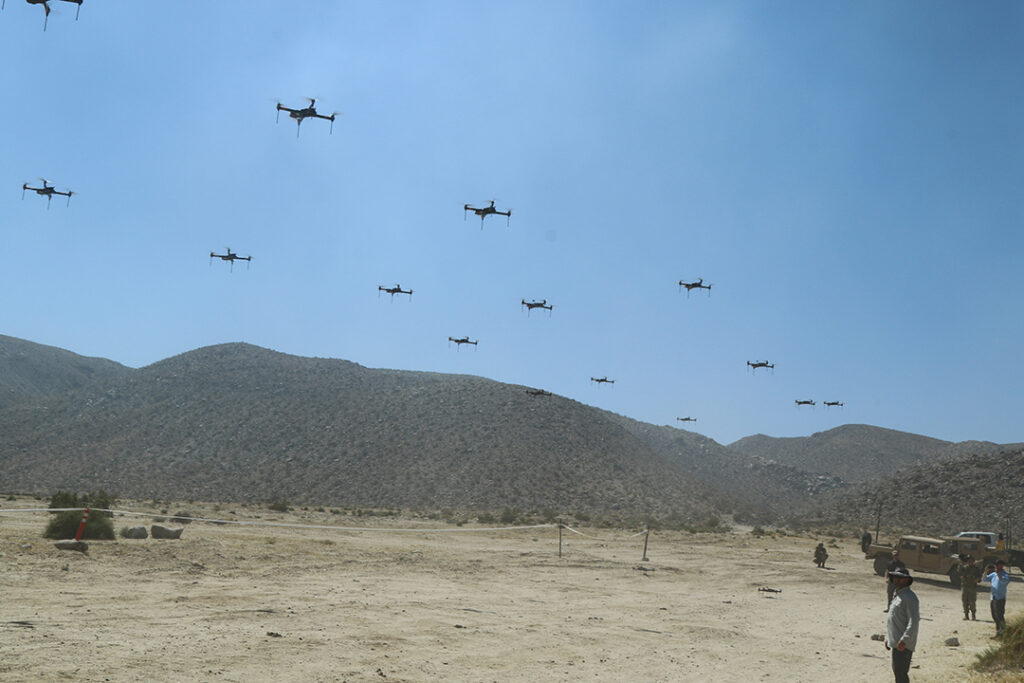THE WATCH STAFF
The U.S. Army will experiment with drone swarms that act in concert to overwhelm potential enemies.
The tests will be carried out at an aviation-focused Army exercise leading up to Project Convergence in the second half of 2022, the director of the service’s Future Vertical Lift Cross-Functional Team (FVLCFT) told Defense News in an April 5, 2022, story.
The aviation exercise, Edge 22, will take place at Dugway Proving Ground in Utah in May. Edge is a prelude to Project Convergence, the Army’s contribution to military-wide Joint All Domain Command and Control (JADC2) that will link data to future land, air, sea, cyber and space capabilities, Defense News said. (Edge stands for Experimental Demonstration Gateway Exercise.)
U.S. Army Maj. Gen. Wally Rugen, who leads FVLCFT, told Defense News that he now describes drone swarms as acting more like wolf packs rather than insects. (Pictured: A swarm of drones during a 2019 U.S. Army exercise.)
“There’s behaviors in the wolf pack,” Rugen said during a media roundtable at the recent Army Aviation Association of America conference, according to Defense News. “It hunts, and there’s an alpha that kind of runs the show and then each wolf has a duty, but then those duties are hierarchical. And if one wolf gets knocked out … a second one’s going [to fill the gap].”
The [drone] swarm is the “largest interactive swarm/pack that I’m aware of that’s ever occurred,” Rugen told Defense News.
The Army has been working with the Defense Advanced Research Projects Agency (DARPA) on the Edge effort, where the service will be joined by seven NATO countries: Australia, Canada, France, Germany, Italy, the Netherlands and the United Kingdom.
“We’ll do a combined air assault with our partners, and I’m very excited about some of the technologies they are bringing to get those cross-domain solutions,” Rugen told Defense News.
The goal is to ensure the Army understands where it can be interoperable with its partners and allies, Rugen said.
The Army awarded a U.S. $14 million contract to BlueHalo in February to develop the swarm capability over a 30-month period, the company announced in a February 24 statement.
The capability is intended to be low cost and will be able to identify and engage threats with the use of a single controller, Stan Darbro, deputy director of the Army Rapid Capabilities and Critical Technologies Office, told Defense News in a March 1 story.
The U.S. Marine Corps is progressing with kamikaze drone swarms, while the Air Force, Navy and DARPA are pursuing separate swarm initiatives, according to a March 1, 2021, story in Forbes magazine.
One U.S. Army study suggested that swarming would make attack drones at least 50% more lethal while decreasing the losses they took from defensive fire by 50%, Forbes reported.
In May 2021, during its conflict with Hamas, the Israel Defense Forces became the first military to use a drone swarm in combat. The swarm reportedly was used to strike dozens of targets in concert with other weapons, according to a December 10, 2021, report by the U.S. Military Academy’s Modern War Institute. The report said that numerous states, including the People’s Republic of China, are developing or acquiring drone swarms.
IMAGE CREDIT: PVT. 2ND CLASS JAMES NEWSOME/U.S. ARMY

